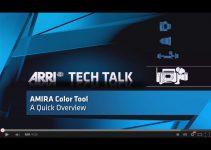In the words of Little Richard, “It’s not the size of the ship; it’s the size of the waves.” Understanding the differences in image sensor sizes amid today’s evolving camera technology is important when determining the look you’re intending to capture as a cinematographer.
Camera manufacturers are continuously dancing around technological advancements and their marketing strategy – blending stills and video cameras, adding megapixels, 4K, 6K, 8K, more dynamic range, new lens mounts, larger sensor sizes, and spinning things into a slurry of somewhat confusing terminology that can often be misleading.
Fortunately, Media Division has put together a terrific explanation of image sensor sizes (1/3″ to IMAX), their history, and how they impact the quality, composition, and perception of the images you’ll capture.
We’re going to focus on the differences between Super 35mm and Full Frame, but dive-in their video is great.
It’s important to note that the size of the sensor has next to nothing to do with resolution – that is a whole another ballgame. But, a large sensor can allow for a larger pixel pitch (larger receptors) which can produce cleaner images with better low light capabilities.
Super 35mm
– Crop Factor: 1.4-1.6x
– Approximate Sensor Size: 24x14mm
– Decent Depth-of-Field
– Adequate Dynamic Range
– Good Low-Light Capabilities
The Super 35 (S35) digital sensor is really a family of varying sizes and is sometimes confused with APS-C sensors in DSLRs. Every manufacturer makes their cameras with a slightly different sized sensor but they still call them Super 35.
For instance, the ARRI Alexa has a sensor that is 4:3, 23.8 x 17.8mm. The Canon C200 uses a 16:9 sensor at 24.6 x 13.8 mm. Panasonic gave the EVA-1 a 4:3 sensor at 24.89 x 18.66 mm.
Blackmagic with their 23.1 x 12.99 mm in the BMPCC 6K. All of these are marketed as Super 35, but if you put the same lens on each of these cameras you’ll end up with a slight variation in the image crop.
And as you can see, there is actually nothing 35mm about it.
The term ‘Super 35’ gets its origins, however, from (you guessed it) 35mm motion picture cameras. Specifically, Super 35 refers to a method of utilizing the space on 35mm film that was usually reserved for the optical audio track to capture a larger image.
This has been around in-one-way-or-another since the 1950s and has also gone through a host of terminology, and size changes as well.
Today, we generally accept Super 35 to mean the image has a 1.4-1.6x crop factor from a Full Frame imager.
Full Frame
– Crop Factor: 1x
– Approximate Sensor Size: 36x24mm
– Outstanding Depth-of-Field
– Excellent Dynamic Range
– Superior Low-Light Capabilities
Full Frame (generally 36 x 24mm but it varies, again, from manufacturer and even camera models) finds it’s origins in 35mm still cameras which only started to matriculate into the video/film world with the addition of video features in the Canon 5D Mark II (circa 2008).
Now there are endless offerings of Full Frame DSLR cameras with video features that shoot glorious images, and the higher-end camera market has followed suit, dubbing these big sensors Large Format or LF.
It’s the same story with LF as well – it’s a marketing term and there are a few cameras out there with slightly varying sized sensors and a whole lot more coming christened as LF.
If you mount the same lens to a camera with a Full Frame sensor vs one with a Super 35 sensor, the Super 35 camera will give you an image that is ~1.5x optically zoomed-in.
A 24mm focal-length lens will have the equivalency of 36mm. A 35mm focal length becomes 52.5mm. Those beloved nifty fifty (50mm) lenses are now 75mm lenses, and so on.
But this doesn’t just mean you’ll have to step further and further back when you’re composing your shots. Full Frame has a completely different look and feel over Super 35, and you can see the difference in your footage.
Full Frame looks more familiar to us because optically it is more similar to how our eyes see and we process those images in our minds. There is a shallower depth-of-focus (more blurry stuff in the background, also called bokeh), and that allows us to focus on (literally isolate) the persons or objects we want our audience to pay attention to in our frame.
The camera can be closer to the subject, giving the resulting image a more intimate feel. The image is cleaner, often offers better exposures in low-light situations, and higher dynamic range.
Super 35 is more classically familiar to us as a cinematic format – the resulting image is what we’re used to seeing in the theater. It doesn’t have as shallow a depth-of-field, and that makes it easier to focus while filming.
More objects are in focus and the viewer gets a clearer picture of the larger frame. But there are also more optical distortions visible in wide lenses such as chromatic aberrations and barrel distortions because you have to use wider lenses that are cropped-in to get the same framing.
Ultimately you should pick the size sensor for the look you’re aiming to capture, and the type of project you’ll be filming. As the sensor sizes grow, the lenses and equipment required tend to get bigger too.
If you’re shooting a scripted narrative film that might not be an issue, but if you’re filming a run-and-gun documentary a smaller and lighter rig will make things a lot easier.
If the ‘cinematic look’ is all you’re after, there is a whole new emerging world of computational photography on the horizon but it really hasn’t reared its head into motion capture just yet.
Soon, however, this will allow video cameras to simulate some of the bokeh effects of Full Frame sensors in post and allow you to select your ‘focus’ later.
A good example of this can be seen in the iPhone 11, and in the new iPad Pro, which has a LiDAR camera for measuring object distances in real time.
Do you prefer Full Frame over Super 35? Can you even tell the difference?
[source: Media Division]
Disclaimer: As an Amazon Associate partner and participant in B&H and Adorama Affiliate programmes, we earn a small comission from each purchase made through the affiliate links listed above at no additional cost to you.
Claim your copy of DAVINCI RESOLVE - SIMPLIFIED COURSE with 50% off! Get Instant Access!





